Chris
The Built Environment - Box Hill
We grew up in Box Hill South in close proximity to Surrey Hills where our family has had an association for five generations. 28 Moore Street was our family home. We all spent our childhood and early adult years there, before moving out on our own. The family ventured out into Box Hill in 1946 when our parents bought a block of land in a new subdivision. They paid one hundred pounds plus ten pounds in taxes. Jim and Alice also looked further out in Donvale, where, for a fraction of the cost, they could have purchased two acres of bush. Unfortunately this was not an option as there was no public transport and we did not own a car.
After the war, Box Hill South was opened up for new housing. The City of Box Hill revised its land valuation system and residential subdivision started to boom across the municipality. The small holdings of mixed farming and orchards, were quickly replaced by the unmade road network of the subdivisions. Electricity and gas were provided, but no sewerage until the 1950’s, so it was outside toilets for all.
Our parents could not afford to have the house built, so Jim decided to build it himself. He bought a book on basic carpentry and the tools, all hand tools of course, and proceeded to build. The house is still there today, straight as a die.
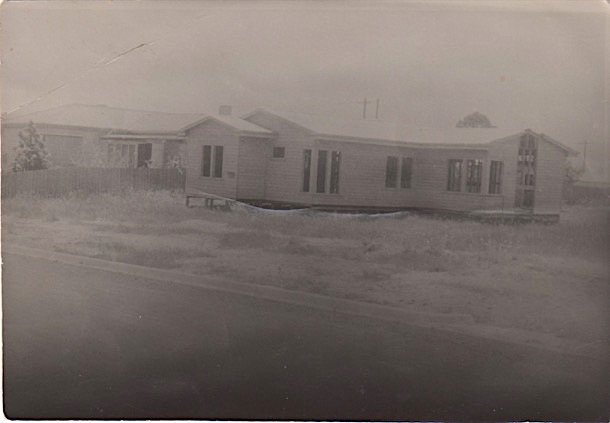
It was a very liveable and rather nice design, set on stumps, weatherboard cladding and with a low slung, pitched roof. It had the standard three bedrooms, one bathroom, kitchen, dining room, lounge room and laundry. When first built there was an outside toilet attached to the single garage that also had a chook pen attached to it.
Over time, the surrounding paddocks filled with houses and our house changed a little too. The view of the Dandenongs from the french doors in the lounge room disappeared, the toilet moved inside and our grandparents built a flat on the back. The addition of the rumpus room and flat spoilt the spaciousness of the living rooms and the back garden. The old weatherboard garage, toilet and chook pen were removed and a new double garage and new chook pen took the new additions to the back fence.
Little appears to have changed externally to the house since Mum sold it about 1981.
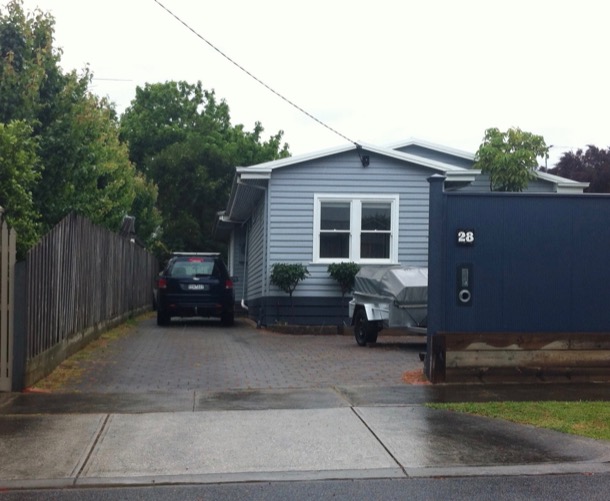
When we were children, Wattle Park itself consisted of large trees with mown grass underneath, like a traditional park, but with native trees and grasses. It was owned and maintained by the Tramways Board, responsible for the tram system in Melbourne. The Tramways brass band played in a rotunda every Sunday in the park. Nowadays those grasses are no longer mown. It looks much more like remnant bushland.
The 137 acres opened as a public park in 1917.
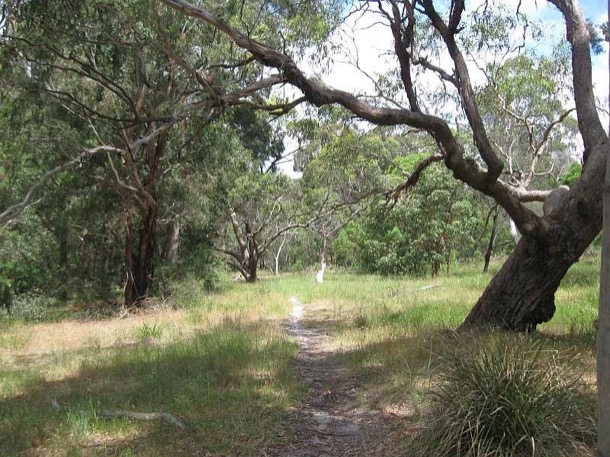
The chalet, designed and built by a Tramways architect, opened in 1928. it was promoted as a dance hall and wedding reception venue and, amazingly, it still is. It is listed on both the Heritage Victoria and National Trust Registers.
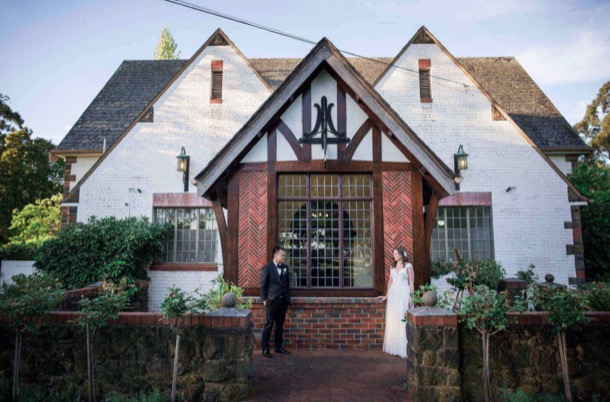
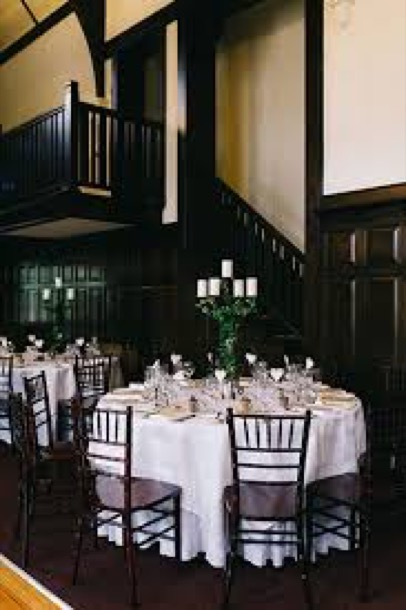
Our own parents’ wedding reception was held there in 1945, after they had been married at the Wyclif Surrey Hills Congregationalist Church in Surrey Hills.
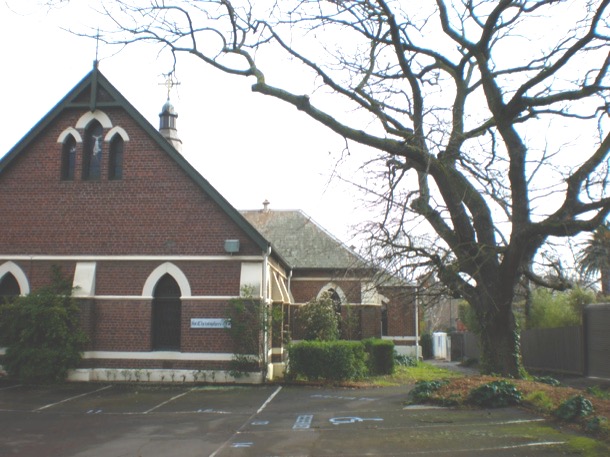
Box Hill Gasworks is now gone, but it was an important part of our parents' history. It was built early in the history of Box Hill:
7/1/1890 The Argus
Some twelve months ago the Nunawading and Boroondara councils granted permission to Mr. Thomas Coates, hydraulic engineer, to lay down gas mains in the streets of the two shires. Mr. Coates purchased an eligible site near Elgar road, Box Hill, upon which to erect the gasometer and the other necessary buildings. At the present time all the mains have been laid down in the shires named, and Mr. Coates is now in a position to light up Surrey Hills and Box Hill with gas. The local works are of such a nature that Mr. Coates contemplates being able to supply the wants of the district for many years to come without enlarging the gasworks. Last night a trial was made in Box Hill and Surrey Hills, when the corporation lamps were lit with gas for the first time. Illumination works were erected at the intersection of the leading streets. The trial was considered a very favourable one, the gas burning bright and clear. In connection with the lighting of these shires with gas a public banquet will be held in Surrey Hills next Monday night.
Over time three gasometers were built.
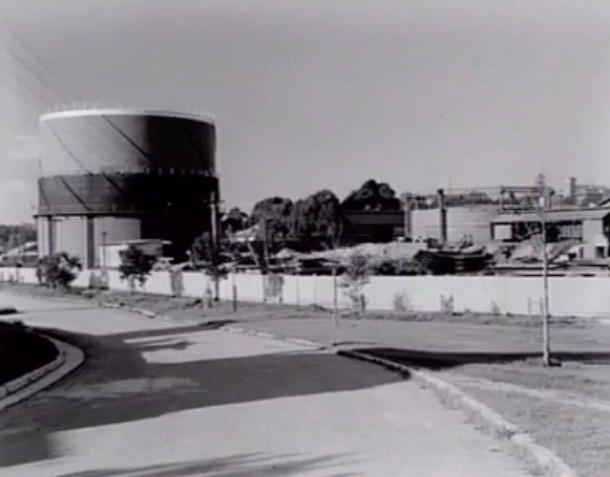
We don't know exactly when Jim started work at the Box Hill Gasworks, but in 1945 he left the Maribinong Munitions factory, where he had spent the war years. It was that year when our parents married and Jim moved into his in-laws’ Surrey Hills house. Soon after, he started work at the gas works as an analytical chemist. He worked there until began teaching in 1954.
Sue remembers him riding his bicycle to work, and later, a motorbike.
He worked in the laboratory, doing things like checking the calorific value of the gas.
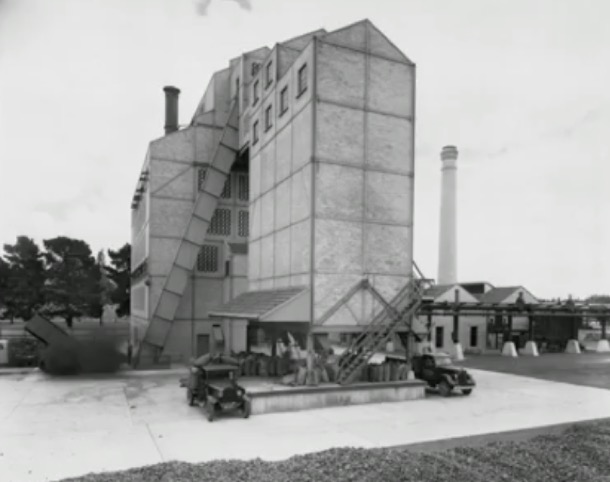
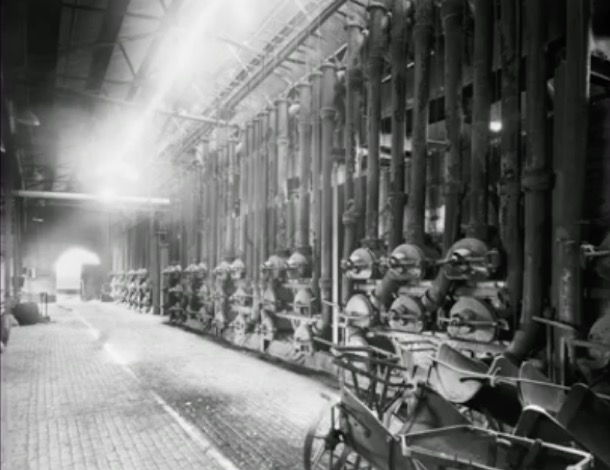
Melbourne’s gas supply was made from Latrobe Valley brown coal, sent by rail to the various gasworks, owned by Colonial Gas Company. Box Hill was one of the biggest. As Melbourne expanded after the war, the demand for gas meant that the various gas works were very busy.
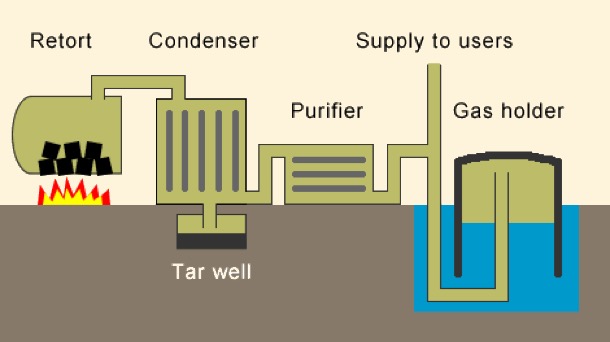
But, by 1960, substantial natural gas reserves had been discovered around Australia. Over the next five years all the Gas plants in Melbourne had closed down, and over 1000 workers were made redundant, by the discovery of natural gas deposit in Bass Strait. Over one million gas appliances in Melbourne were converted to natural gas in 1968. We remember the conversion time. There must have been plenty of publicity. Natural gas has no smell, and, for safety, they put in an additive to make it smell quite strongly. The flame was slightly different, but all the existing burners still worked.
The Gas Works are long gone. Box Hill Institute now occupies the site.
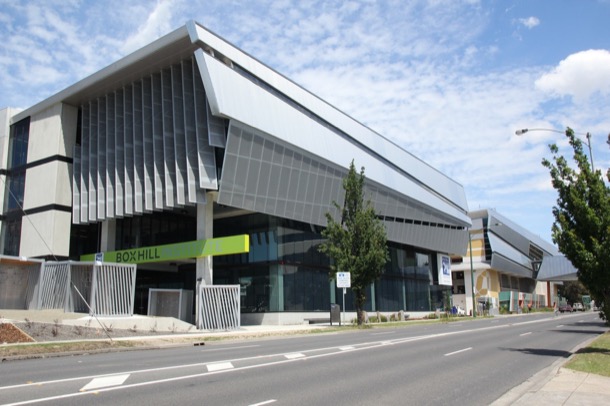
One of the fortnightly highlights in our simple lives was a trip to Box Hill Library. We loved this excursion, as we spent many hours reading on our beds. Books were expensive and we only owned a few. We had to rely on the Library so that we could finish our favourite series like Famous Five and the Billabong Books. It was very exciting if the next book in the series was on the shelf.
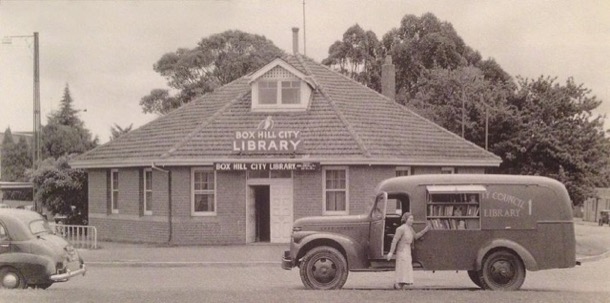
This small brick building was opposite the Town Hall at the end of the shopping centre. Whitehorse Road always had a wide, tree lined median strip, as it does today, and the library was right in the middle. It was later replaced by a grand modern library, but the small brick building is still there.
In our childhood, a trip to Box Hill shopping centre was quite an excursion, involving a four mile walk. In 2019 Google Maps says it takes thirty two minutes, but with small legs and a pusher as well, maybe it took a little longer. I remember it was fun and not arduous at all. The route went through suburban streets until Canterbury Road and from there it was ovals and open ground.
Box Hill Brickworks was one of the best sights on the walk to Box Hill, as the brickworks were still in full production. We marvelled at how small the men and carts were at the bottom of the quarry, and watched the procession of carts pass up and down the steep rail track to the actual brick works.
Box Hill Brickworks was founded in 1884 and was one of fifty or so brickworks throughout Melbourne, producing bricks, tiles and pipes for the building boom and ever expanding city. During the working life of the brickworks the clay was extracted from two clay holes or quarries. The first became Surrey Dive which became a popular swimming venue, but off limits to us. Sometimes however, we also gave ourselves the horrors, looking at green, mysterious waters. There were rumours of 'the dive' being bottomless and of swimmers disappearing in its murky depths. One story was of a man who took a very deep dive off the cliff side and simply disappeared. Some time later his body surfaced in Blackburn Lake, five kilometres away. No wonder we looked in awe and horror through the fence.
Today Surrey Dive is an attractive small urban lake used for swimming and remote controlled boat races.. A walking track around the ‘old dive’ and the brick works is planted with indigenous vegetation and a relaxing and attractive area.
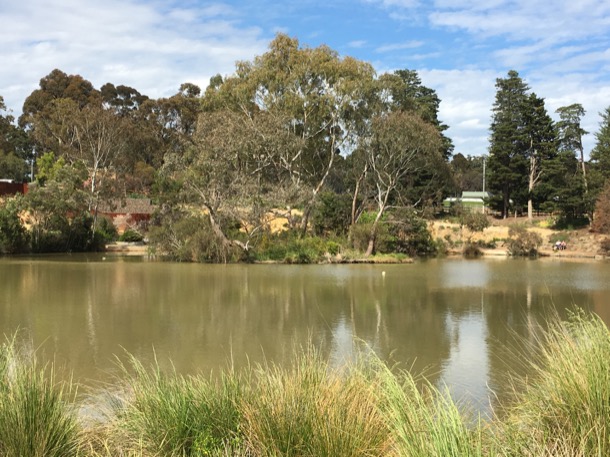
The other clay hole was the quarry that was in operation doing our childhood. It was adjacent to the brickworks and kiln, now derelict but still heritage listed. Unfortunately no restoration work has been carried out. The kiln itself was a massive, red brick building constructed on two levels and, of course, with a huge brick chimney.
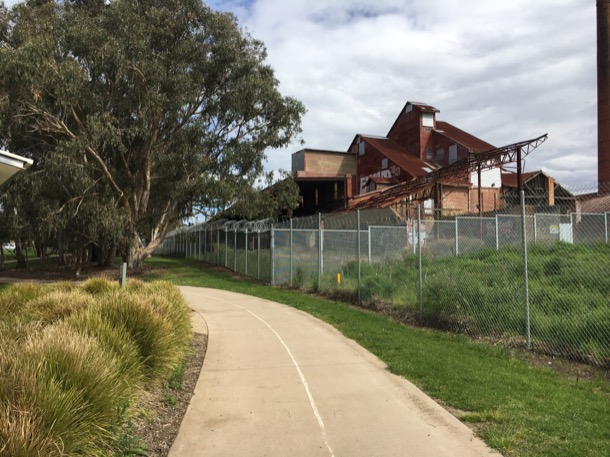
The quarry that was still in full production in our childhood, is now completely filled in. That cavernous hole in the ground is now a large mound covered in every weed known to man. On the horizon above the weeds, are the sky scrapers of twenty-first century Box Hill.
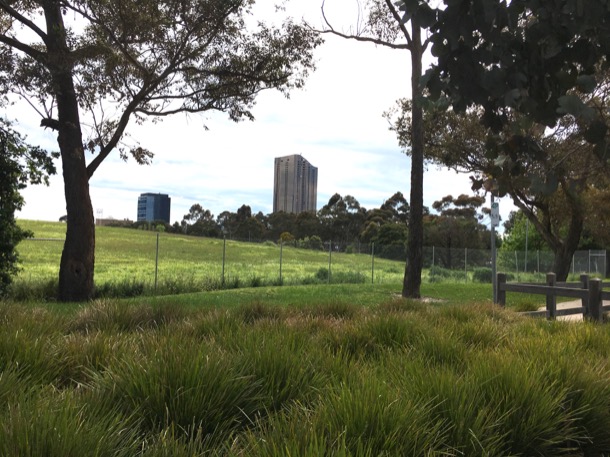
Box Hill shopping centre developed as a commercial centre, as soon as the railway line between Hawthorn and Lilydale was finished in 1862. It became an important transport hub for the eastern suburbs and beyond. During our childhood, Box Hill was the shopping destination for a big purchases. For instance, I can remember choosing a ‘walking’ doll with opening and closing eyes for a birthday present and the excitement of choosing a winter coat with a brown velvet collar. Another favourite shop was the delicatessen where such delicacies as rollmops, sauerkraut and frankfurters could be bought. Amongst the many single fronted small businesses were several large shops such as Taits haberdashery on the corner of Whitehorse Road and Station Street and Maples furniture shop. We also had a Coles variety store that sold anything from socks and singles to cosmetics, and MacEwans Hardware whose slogan was, “You can do it with McEwans because we’ve got a million things.”
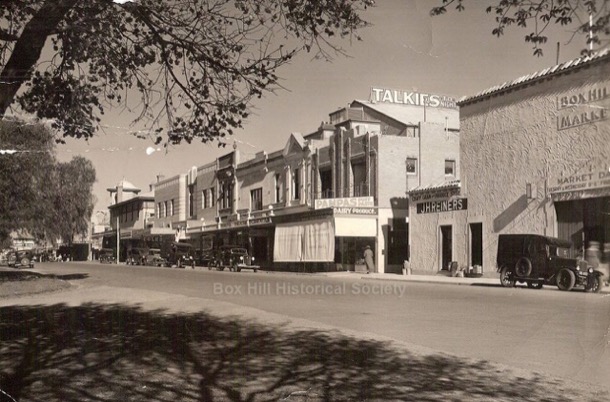
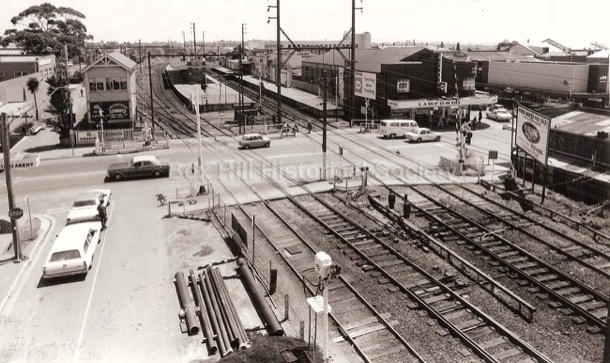
This is a photograph of Box Hill Station and the surrounding shopping precinct in the 1960s. In the centre of the photograph is the old station, that is now underground. Today, above ground, occupying the whole block surrounding the old station, is Box Hill Central and surrounding shopping malls. The signal box, the tall structure on the left of the railway gates is now occupied by the thirty-six storey golden residential tower, called Sky-One.
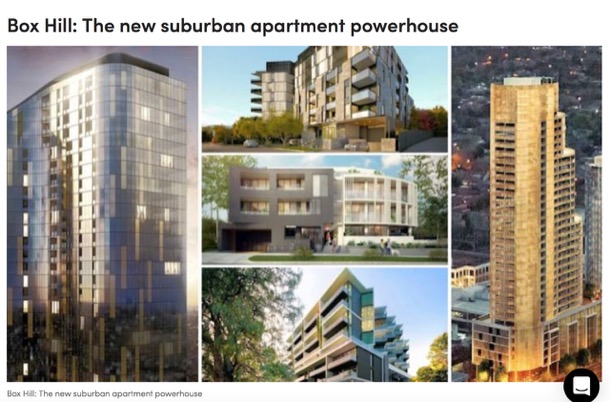
In the twenty-first century, Box Hill, as a commercial centre and transport hub, continues to influence the built environment around it, as you have no doubt witnessed. Officially designated as a development hub, Box Hill now sports high rise office and apartment towers. The streets we once drove down are now shopping malls, the station is underground, the railway gates are long gone and the strip shops have been replaced by a multi storey modern shopping centre. When we were children the shopping crowds were white and Anglo-Saxon. Today they are predominately Asian and the shops and restaurants reflect the change in population.
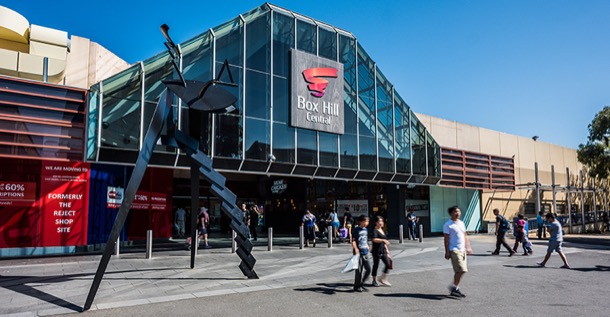
When we, as a family, first started going to the local Presbyterian church, it was called Presbyterian, Wattle Park. We had PWP embroidered on the front of our blue gym uniforms. This was before the advent of the Uniting Church. Church services were held in a cream brick building, called Forsythe Hall.
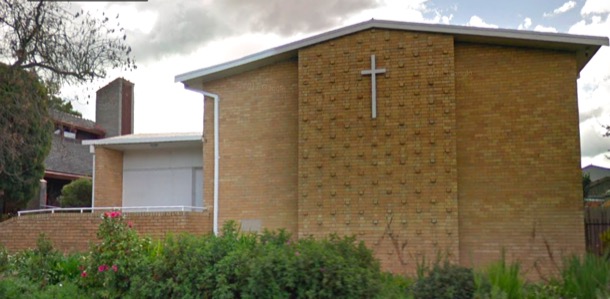
Attached, behind it, was an older little wooden building. During our childhood, this wooden building, Staley Hall, was used for a kindergarten during weekdays. In the evenings, various groups used it, including church boys’ and girls’ clubs (PBA and PGA) and the mixed club (PFA- Presbyterian Fellowship Association), we went to as teenagers. Sue and I both learnt to dance there, and I broke my front teeth on the heater in that room.
We have many memories of Forsyth Hall… dances, performances, Saturday afternoon movies, gym classes and, of course church services.
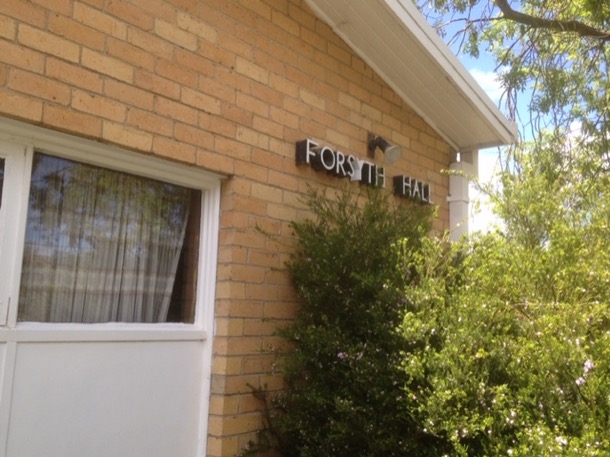
Both our parents were Elders of the church. Our mother taught Sunday School, our father ran the PFA for a while, and was on the board of management. The church was their only real friendship group, and was the only social life we had, as a family.
In the early 1960s the church community began the project of building a new church on the site. The size and scale of the project was a source of much disagreement between our father and others on the management committee.
In the end, a very grand architect designed building was commissioned. The new building was designed by well known architects Chandler & Patrick. An 1887 pipe organ was relocated from a church in Melbourne and extensively rebuilt. The new church, renamed St James, opened in 1965.
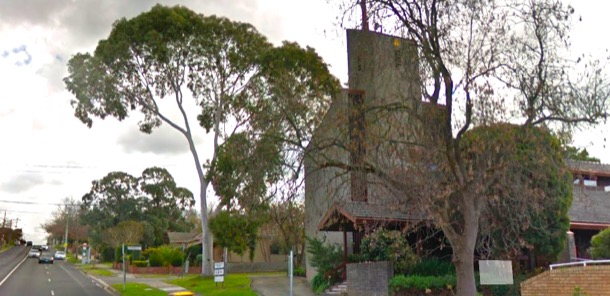
I loved it, because I sang in the church choir, and it had a choir loft at the back and great acoustics.
The buildings are still there. Sue and I visited as a detour on our “back to school” walk in 2016.
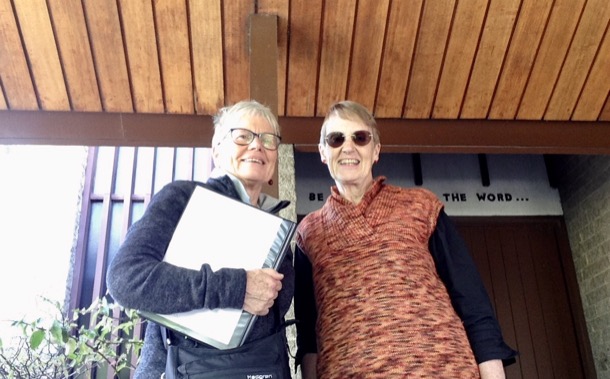
Comments
I can hear sleigh bells
13 12 17 15:36 Filed in: Children 1950s | Teenagers 1960s
Christmas has always been a special time in our lives. It is not surprising, I suppose, as the whole of society gears up for this event. Now in our multicultural society, Christmas is driven by commercialisation. When we were growing up, everyone in our world was ‘Anglo’ and many people went to church. For us too, Christmas was one of the few variations from routine, and one of the few times in a year when we went visiting.
Christmas also marked the end of the school year and the beginning of holiday preparations. When we were very young, this involved a wonderful week staying with Pauline, Auntie Marge and Uncle George and later, the huge preparations for camping at Shoreham.
In our minds, Christmas preparations are linked with images of Mum sewing at the kitchen table: cotton ends; bits of material with paper patterns pinned to them; kids standing still to have hems pinned up; and the last minute wrapping of presents amongst the sewing detritus. Dad was packing the trailer and driving to Shoreham to set up the tent. Our parents must have been very busy, but we remember it as a very happy time. Margaret and I remember decorating the tree, that was of course a pine tree.
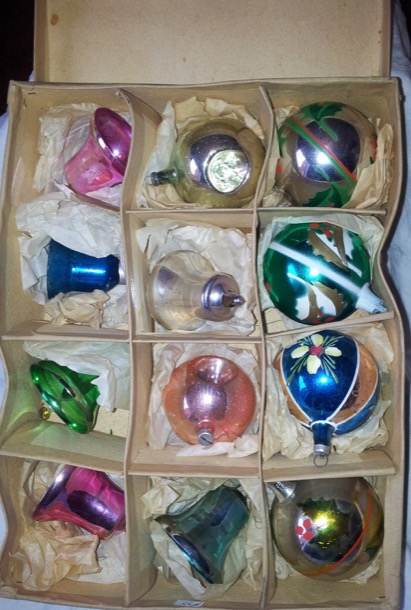
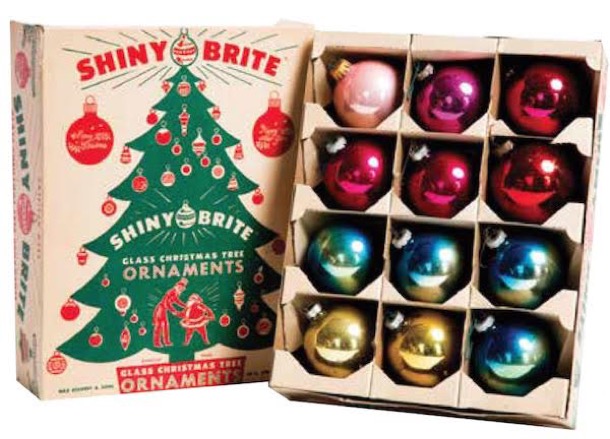
Christmas baubles were made of glass: fragile and expensive.
Choosing the tree was quite a process, as was the decorating, as trees were irregular shapes, not manicured as they are today.
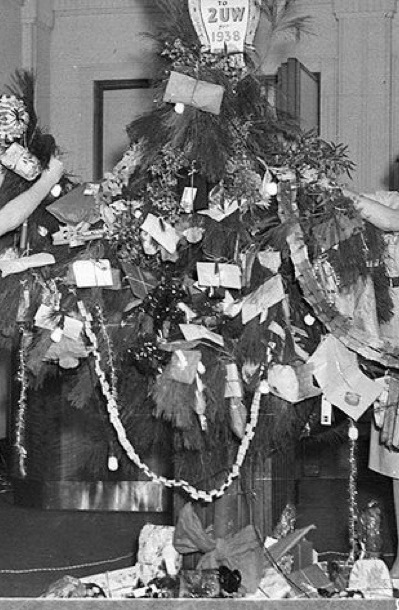
With Mum so busy sewing, it was also easy to slip unnoticed into the dark, tall built-in cupboard in their bedroom, where every year, on the second top shelf, mysterious exciting items in brown paper bags were stored. We remember doing quite a bit of poking and prodding, but never unwrapping and having a real good look. This would have to wait until Christmas morning.
Margaret and I also saved our pocket money for Christmas and bought presents for Aunts, Uncles, Great Aunts and Grandparents. We had wonderful fun in the Coles Emporium in Box Hill choosing the most wonderful pressies.
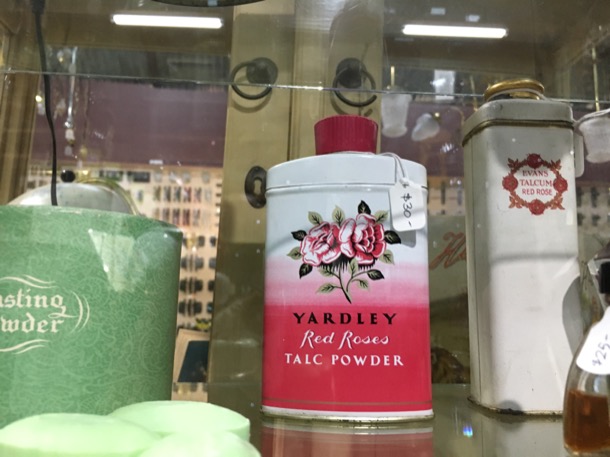
We choose strong smelling bath salts for Auntie Bert, delightful ornaments for Grandma Bourke, talcum powder for Auntie Tish and often disappointingly, hankies for the men, as they were very hard. The shops, even the department stores, were very, very different. A few Christmas decorations were evident, but shops generally were less cluttered, as there was little if any self service.
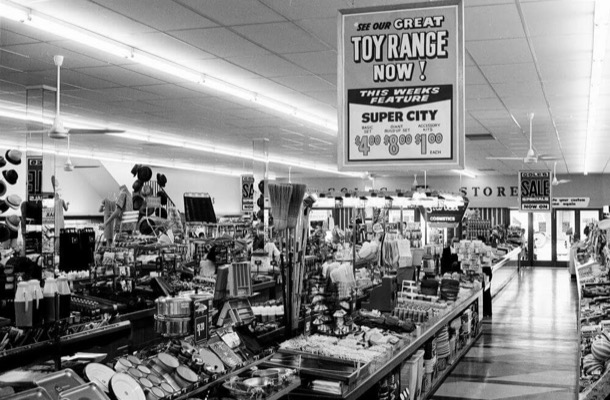
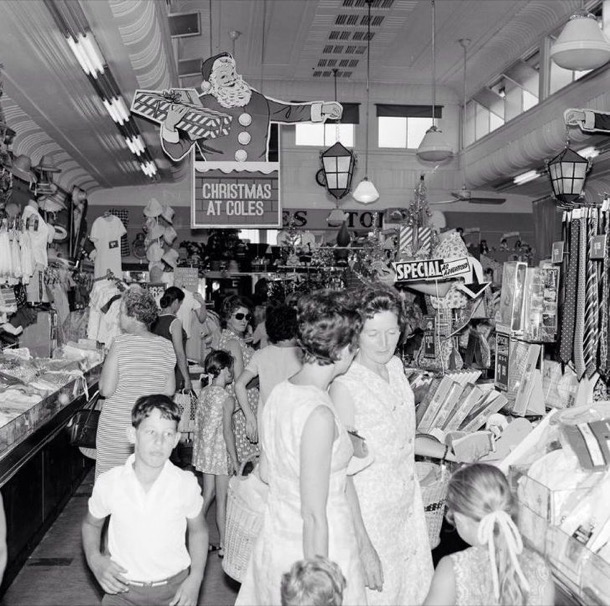
Once purchased and examined we wrapped the presents, made and wrote cards, and either posted or delivered them personally on Christmas Day. Sometimes we also made presents. One year it was calendars. We made them with a prepared calendar printed format and found interesting pictures to paste in for each month. Great fun!
Another delightful memory is of the Salvation Army brass bands who marched the suburban streets before Christmas, stopping every now and again to play three or four carols on a corner. If we were lucky they would stop nearby and we could peer out the window and see them in their uniforms playing the shiny brass instruments. It was always disappointing to hear the tread of feet in unison, as they marched away to the next spot.
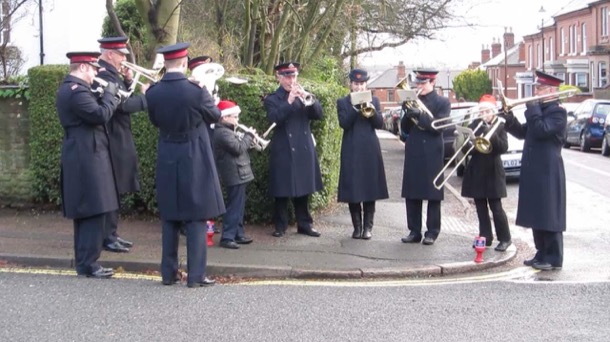
One such very hot night , Christmas Eve actually, the Salvation Army Band had moved on and apparentIy I convinced Margaret that we could hear sleigh bells. Margaret is not sure of it but I am!
I must have been about seven or eight when my suspicions about the identity of Father Christmas were confirmed, although I did still try to deny it and believe for a few years after that. We were staying in a little fibro holiday house in Rosebud with another family. The children were squashed in together in one room, on beds and mattresses on the floor. Late on Christmas Eve, I saw two figures, our parents, laden with crinkly, crunchy pillowcases, stumbling around the crowded room putting the ‘sacks’ on the respective beds. I remember telling Mum that I had seen them, and being cautioned to keep the knowledge to myself. I did!
Christmas Eve for us didn’t involve special preparations or rituals, other than the placing of a pillow slip on the end of each bed. We called these “sacks”. Sue remembers “hearing” Santa’s sleigh bells one year, and sometimes the Salvos street-corner concert would be on this special night, but generally the excitement began on waking.
As soon as I remembered the specialness of this particular morning, I would reach out my toes and touch the lumpy sack that now took up a good ideal of the bottom of the bed. The crinkle of wrapping paper and the solidity of its contents were thrilling. Sue and I shared a room, and the first one awake would wake the other. I guess we woke the two boys too, or perhaps they woke us up.
The ritual was then for each of us to carry our sacks up the hall to our parents’ room and have a mass unwrapping there, on their bed.
When Sue and I talked at length about our reminiscences of our childhood Christmases, one of us raised the question of what presents we remember. The answer is: hardly any. And yet we had very few toys, and only two occasions, Christmas and birthdays, when we got any.
“Stuff” was very expensive and in short supply when we were little. And clearly it was not terribly important in our lives. In our sacks there were one or two intriguing and fairly roughly wrapped parcels. There might be a toy, maybe some “special” clothes, a bag of mixed lollies, chocolate coins, eaten then and there, and little else. One year we were given hard cover bibles, (not very exciting). Later in the day, we presume there were presents from other family members, but we do not remember the actual items, just the excitement of unwrapping and the specialness of the occasion.
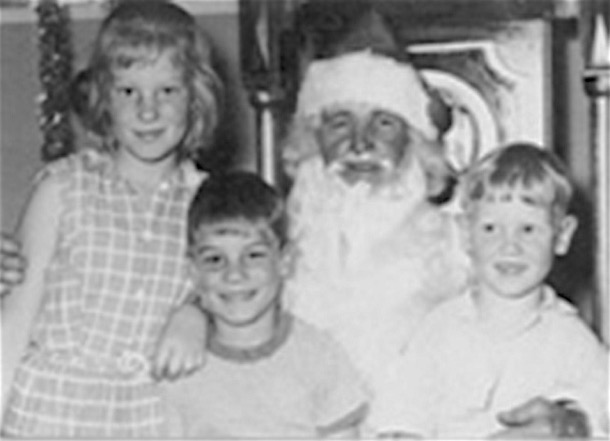
A rare Christmas picture, about 1962. Margaret, Ian and Chris.
One Christmas morning I do clearly remember, was when I woke to find a trail of wool from my sack leading to the large room at the back of the house we called the rumpus room. When I reached the end of it there was a card telling me that my new piano would be placed here. There was a corresponding card on my sack saying that the next year I would start having piano lessons. I had been asking whether I could learn the piano for some time, and, looking back from here, it seems as if I knew that this was going to be very significant in my life.
Other presents we remember which could just as easily have been birthday presents are:
The joint present to all of us of a swing. We got out there early on Christmas morning to use it, and made ourselves sick.
A pogo stick, another joint present.
Roller skates, which attached to our shoes. (Only the boys had bicycles, though we had tricycles when we were really little)
Dolls: mine was black and Sue’s caucasian.
Beach toys, such as bucket and spade, and, later, rubber blow up surf matts.
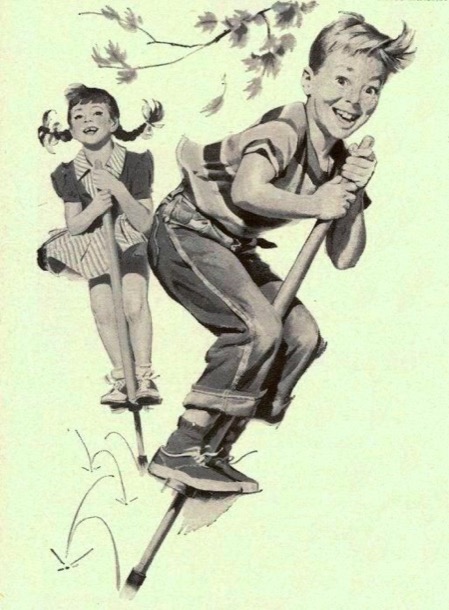
After we had strewn our parents’ bedroom with paper and eaten far too many lollies and chocolates, we had our usual breakfast of cereal, sugar and milk, put on our “best” dresses, socks and either our school shoes, or sandals (we only owned one pair of each) and headed off to church.
Sue remembers the Christmas church service as “a little less boring than usual”. For me, church was all about the music. The Christmas church service was overflowing with once-a-year-Christians and there was an air of excitement among all age groups.
After church there was a small, not very special lunch at home, and our mother doing last minute wrapping of presents for the afternoon. Then, I guess still wearing our best, (although some of us were quite prone to getting extremely dirty extremely quickly), we headed off for the afternoon at Grandma Bourke’s place.
It is about this part of Christmas Day that I have the clearest recollections.
We have written in another post (“Cut out of the Will” 15/6/2016) about our parents’ ”mixed marriage” and the disapproval with which their union was viewed.
Our mother called her mother in law “Mrs Bourke”, which was also her own name of course. We were aware of the tensions between them, and acutely aware of the warmth and familiarity between “Grandma Bourke” and her other grandchildren, who lived in the country and stayed with her every Christmas. They called her “Gannar”.
Presents were exchanged, as we sat in a circle. Interestingly, while we can remember giving presents to the grown ups, Grandma, Auntie Tish and Uncle Matt, we don’t remember any specifics of the presents we were given.
Mostly, for us, these visits were about the food. Afternoon tea, in the front room, stuffed full of dark furniture, was a grand affair. There was a huge silver teapot with its cosy, on a double decker tea trolley with cups and saucers. There was cake, slices and delicious savouries in huge quantities.
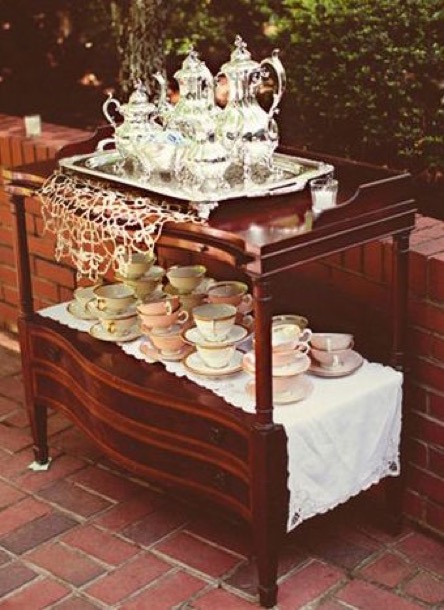
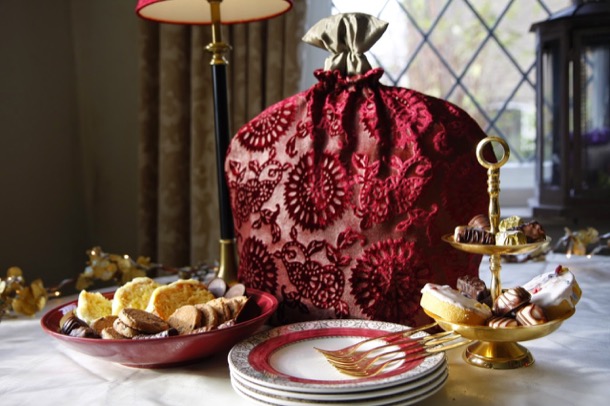
The grownups made conversation, about things that were not of our world: the races, farming the sheep property that Uncle Matt owned in the Western District, television, (Grandma Bourke was a huge fan of Graham Kennedy) and people we didn’t know.
Afterwards we children went outside under the weeping elm tree in the front yard, to play. It is only there I have any memory of interacting with our cousins, and not much there either. They were younger than us, and lived in a very different world. Occasionally our other cousins, Uncle Jack’s children, even less familiar, would come to visit on Christmas Day.
Some years, this was the end of Christmas for us. We went home for a light dinner and woke up to the rest of the holidays, which, in later years, meant six weeks camping at Shoreham.
Sometimes, though, we went on from Grandma Bourke’s in Hawthorn, to Beaumaris and our mother’s sister’s place. After the stiff, tense formality of Grandma Bourke’s, Auntie Marge’s warm welcome and the relaxation of playing with our familiar cousin Pauline, was a huge relief. We would have a wonderful meal and exchange presents lounging around the floor in the spacious living room. There was even a glass of wine (Penfolds Moselle in a flagon) with dinner for some of the adults. Alcoholic drinks did not feature in our parents’ lives.
We did not see our maternal grandparents on Christmas Day. We have no memory of them sharing anything Christmassy with us, even when they were living with us.
Most families have developed Christmas traditions. We remember Christmas as being confined to the day itself and the night before, and we suspect this might have been a common thing in those days. Our family did not entertain. There were never any parties, even family parties. When we look back on this time, and compare it to what kids these days experience as Christmas, it was pretty sparse. Sue and I, reflecting on our childhood Christmases, are aware of, and a bit surprised at, how warmly we remember them.
Christmas also marked the end of the school year and the beginning of holiday preparations. When we were very young, this involved a wonderful week staying with Pauline, Auntie Marge and Uncle George and later, the huge preparations for camping at Shoreham.
In our minds, Christmas preparations are linked with images of Mum sewing at the kitchen table: cotton ends; bits of material with paper patterns pinned to them; kids standing still to have hems pinned up; and the last minute wrapping of presents amongst the sewing detritus. Dad was packing the trailer and driving to Shoreham to set up the tent. Our parents must have been very busy, but we remember it as a very happy time. Margaret and I remember decorating the tree, that was of course a pine tree.


Christmas baubles were made of glass: fragile and expensive.
Choosing the tree was quite a process, as was the decorating, as trees were irregular shapes, not manicured as they are today.

With Mum so busy sewing, it was also easy to slip unnoticed into the dark, tall built-in cupboard in their bedroom, where every year, on the second top shelf, mysterious exciting items in brown paper bags were stored. We remember doing quite a bit of poking and prodding, but never unwrapping and having a real good look. This would have to wait until Christmas morning.
Margaret and I also saved our pocket money for Christmas and bought presents for Aunts, Uncles, Great Aunts and Grandparents. We had wonderful fun in the Coles Emporium in Box Hill choosing the most wonderful pressies.

We choose strong smelling bath salts for Auntie Bert, delightful ornaments for Grandma Bourke, talcum powder for Auntie Tish and often disappointingly, hankies for the men, as they were very hard. The shops, even the department stores, were very, very different. A few Christmas decorations were evident, but shops generally were less cluttered, as there was little if any self service.


Once purchased and examined we wrapped the presents, made and wrote cards, and either posted or delivered them personally on Christmas Day. Sometimes we also made presents. One year it was calendars. We made them with a prepared calendar printed format and found interesting pictures to paste in for each month. Great fun!
Another delightful memory is of the Salvation Army brass bands who marched the suburban streets before Christmas, stopping every now and again to play three or four carols on a corner. If we were lucky they would stop nearby and we could peer out the window and see them in their uniforms playing the shiny brass instruments. It was always disappointing to hear the tread of feet in unison, as they marched away to the next spot.

One such very hot night , Christmas Eve actually, the Salvation Army Band had moved on and apparentIy I convinced Margaret that we could hear sleigh bells. Margaret is not sure of it but I am!
I must have been about seven or eight when my suspicions about the identity of Father Christmas were confirmed, although I did still try to deny it and believe for a few years after that. We were staying in a little fibro holiday house in Rosebud with another family. The children were squashed in together in one room, on beds and mattresses on the floor. Late on Christmas Eve, I saw two figures, our parents, laden with crinkly, crunchy pillowcases, stumbling around the crowded room putting the ‘sacks’ on the respective beds. I remember telling Mum that I had seen them, and being cautioned to keep the knowledge to myself. I did!
Christmas Eve for us didn’t involve special preparations or rituals, other than the placing of a pillow slip on the end of each bed. We called these “sacks”. Sue remembers “hearing” Santa’s sleigh bells one year, and sometimes the Salvos street-corner concert would be on this special night, but generally the excitement began on waking.
As soon as I remembered the specialness of this particular morning, I would reach out my toes and touch the lumpy sack that now took up a good ideal of the bottom of the bed. The crinkle of wrapping paper and the solidity of its contents were thrilling. Sue and I shared a room, and the first one awake would wake the other. I guess we woke the two boys too, or perhaps they woke us up.
The ritual was then for each of us to carry our sacks up the hall to our parents’ room and have a mass unwrapping there, on their bed.
When Sue and I talked at length about our reminiscences of our childhood Christmases, one of us raised the question of what presents we remember. The answer is: hardly any. And yet we had very few toys, and only two occasions, Christmas and birthdays, when we got any.
“Stuff” was very expensive and in short supply when we were little. And clearly it was not terribly important in our lives. In our sacks there were one or two intriguing and fairly roughly wrapped parcels. There might be a toy, maybe some “special” clothes, a bag of mixed lollies, chocolate coins, eaten then and there, and little else. One year we were given hard cover bibles, (not very exciting). Later in the day, we presume there were presents from other family members, but we do not remember the actual items, just the excitement of unwrapping and the specialness of the occasion.

A rare Christmas picture, about 1962. Margaret, Ian and Chris.
One Christmas morning I do clearly remember, was when I woke to find a trail of wool from my sack leading to the large room at the back of the house we called the rumpus room. When I reached the end of it there was a card telling me that my new piano would be placed here. There was a corresponding card on my sack saying that the next year I would start having piano lessons. I had been asking whether I could learn the piano for some time, and, looking back from here, it seems as if I knew that this was going to be very significant in my life.
Other presents we remember which could just as easily have been birthday presents are:
The joint present to all of us of a swing. We got out there early on Christmas morning to use it, and made ourselves sick.
A pogo stick, another joint present.
Roller skates, which attached to our shoes. (Only the boys had bicycles, though we had tricycles when we were really little)
Dolls: mine was black and Sue’s caucasian.
Beach toys, such as bucket and spade, and, later, rubber blow up surf matts.

After we had strewn our parents’ bedroom with paper and eaten far too many lollies and chocolates, we had our usual breakfast of cereal, sugar and milk, put on our “best” dresses, socks and either our school shoes, or sandals (we only owned one pair of each) and headed off to church.
Sue remembers the Christmas church service as “a little less boring than usual”. For me, church was all about the music. The Christmas church service was overflowing with once-a-year-Christians and there was an air of excitement among all age groups.
After church there was a small, not very special lunch at home, and our mother doing last minute wrapping of presents for the afternoon. Then, I guess still wearing our best, (although some of us were quite prone to getting extremely dirty extremely quickly), we headed off for the afternoon at Grandma Bourke’s place.
It is about this part of Christmas Day that I have the clearest recollections.
We have written in another post (“Cut out of the Will” 15/6/2016) about our parents’ ”mixed marriage” and the disapproval with which their union was viewed.
Our mother called her mother in law “Mrs Bourke”, which was also her own name of course. We were aware of the tensions between them, and acutely aware of the warmth and familiarity between “Grandma Bourke” and her other grandchildren, who lived in the country and stayed with her every Christmas. They called her “Gannar”.
Presents were exchanged, as we sat in a circle. Interestingly, while we can remember giving presents to the grown ups, Grandma, Auntie Tish and Uncle Matt, we don’t remember any specifics of the presents we were given.
Mostly, for us, these visits were about the food. Afternoon tea, in the front room, stuffed full of dark furniture, was a grand affair. There was a huge silver teapot with its cosy, on a double decker tea trolley with cups and saucers. There was cake, slices and delicious savouries in huge quantities.


The grownups made conversation, about things that were not of our world: the races, farming the sheep property that Uncle Matt owned in the Western District, television, (Grandma Bourke was a huge fan of Graham Kennedy) and people we didn’t know.
Afterwards we children went outside under the weeping elm tree in the front yard, to play. It is only there I have any memory of interacting with our cousins, and not much there either. They were younger than us, and lived in a very different world. Occasionally our other cousins, Uncle Jack’s children, even less familiar, would come to visit on Christmas Day.
Some years, this was the end of Christmas for us. We went home for a light dinner and woke up to the rest of the holidays, which, in later years, meant six weeks camping at Shoreham.
Sometimes, though, we went on from Grandma Bourke’s in Hawthorn, to Beaumaris and our mother’s sister’s place. After the stiff, tense formality of Grandma Bourke’s, Auntie Marge’s warm welcome and the relaxation of playing with our familiar cousin Pauline, was a huge relief. We would have a wonderful meal and exchange presents lounging around the floor in the spacious living room. There was even a glass of wine (Penfolds Moselle in a flagon) with dinner for some of the adults. Alcoholic drinks did not feature in our parents’ lives.
We did not see our maternal grandparents on Christmas Day. We have no memory of them sharing anything Christmassy with us, even when they were living with us.
Most families have developed Christmas traditions. We remember Christmas as being confined to the day itself and the night before, and we suspect this might have been a common thing in those days. Our family did not entertain. There were never any parties, even family parties. When we look back on this time, and compare it to what kids these days experience as Christmas, it was pretty sparse. Sue and I, reflecting on our childhood Christmases, are aware of, and a bit surprised at, how warmly we remember them.

